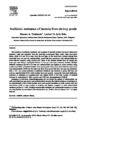Antibiotic resistance of bacteria from shrimp ponds
Share
Abstract
The incidence of antibiotic resistance was compared in bacteria isolated from pond water, pond sediment, water and sediment from the receiving environment (area where water from pond drains, which is 0 and 50 m away from the exit gate, in this study) and cultured shrimp from ponds that have not used any antimicrobials, ponds that have previously used antimicrobials and ponds that are currently using oxolinic acid. Most of the bacteria isolated from all sample and pond type were Vibrios. Among the Vibrios, V. harveyi were most commonly isolated. Multiple antibiotic resistance (MAR) to at least two antimicrobials was highest in ponds currently using oxolinic acid (24% of bacteria isolated from such ponds), followed by those that have previously used antimicrobials (19%) and the least was those from ponds that have not used any antimicrobials (17%). The lowest incidence of antibiotic resistance was observed in ponds that have not used any antimicrobials (41% of the isolates from such ponds). Among the individual antibiotics, incidence of resistance to oxytetracycline was highest (4.3% of the total number of isolates) followed by furazolidone (1.6%), oxolinic acid (1%) and chloramphenicol (0.66%).
Resistance to individual chemotherapeutants did not reflect the pattern of antimicrobial use with ponds that have previously used antimicrobials showing the highest incidence of resistance to one antimicrobial (12% of total isolates from such ponds). Resistance to both oxolinic acid and furazolidone (15% of total number of isolates) was highest compared to other antimicrobial resistance profiles (1–12%). Multiple antimicrobial resistance and intermediate reaction to at least one antimicrobial are associated with antimicrobial use.
Suggested Citation
Tendencia, E., & de la Peña, L. D. (2001). Antibiotic resistance of bacteria from shrimp ponds. Aquaculture , 195(3-4), 193-204. https://doi.org/10.1016/S0044-8486(00)00570-6
Collections
- AQD Journal Articles [1249]

